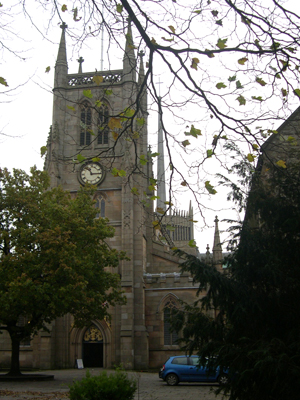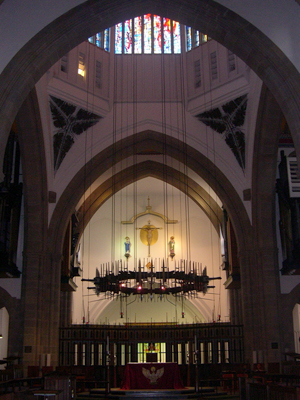| |
 |
 |
 |
| Comment on this report, or find other reports. |
 |
| Our Mystery Worshippers are volunteers who warm church pews for us around the world. If you'd like to become a Mystery Worshipper, start here. |
 |
| Find out how to reproduce this report in your church magazine or website. |
|
|
| 1652: Blackburn
Cathedral, Lancashire, England |
 |
 |
 |
Mystery Worshipper:
Chris Teean.
The church:
Cathedral
Church of St Mary the Virgin, Blackburn, Lancashire, England.
Denomination:
Church of England, Diocese
of Blackburn.
The building:
The diocese of Blackburn was created in 1926, and the parish
church of St Mary, built in 1820 in the Gothic Revival style
on a site of Christian worship reaching at least as far back
as the 14th century, was enlarged to serve as the diocese's
cathedral. The original church constitutes the nave, with sanctuary,
transepts and the eastern chapels added during the 1930s and
continuing into the 1960s. On entering, the eye is drawn to
the altar, above which is suspended a steel corona, representing
Christ's crown of thorns, lit via the lantern in the tower above.
The distinctive lantern tower features brightly coloured stained
glass that casts beautiful shadows when the sun shines. It is
internally illuminated at night. Altar, corona and lantern are
all the work of the noted stained glass artist John Hayward.
At the west door is a huge sculpture of Christ the worker, also
by Hayward. The whitewashed nave features a collection of 15
images called The Journey, by the contemporary painter Penny
Warden. Near the north transept is a statue of Madonna and Child
by Josefina de Vasconcellos, who until her death in 2005 at
age 100 was thought to be the world's oldest living sculptor;
her works adorn parish churches and cathedrals throughout England.
As you walk round the statue, you can see conflicting expressions
of happiness, adoration and sorrow on the Madonna's face. In
the chapels can be found some interesting statues, icons and
other religious objects, including a reproduction of a rare
15th century pax-brede, the original of which was found hidden in the churchyard in 1820.
The church:
Morning prayer and either evening prayer or evensong are prayed
each day. There is also a eucharist every weekday, with three
masses on Sundays. Sunday school, preparation for confirmation,
and adult enquirer's classes are also offered. A Mothers' Union
and a Cathedral Ringers group hold regular weekly meetings.
The cathedral also hosts various musical events, including organ
recitals and a Blackburn Music Society concert. Finally, they
are very much involved in dialogue with the Muslim community.
The neighbourhood:
Lying in eastern Lancashire to the north of the West Pennine
Moors and on the southern edge of the Ribble Valley, Blackburn
is a large dilapidated town that has seen better days. It has
produced textiles since the middle of the 13th century; James
Hargreaves, inventor of the spinning jenny, was a weaver in
Blackburn. However, textile production fell into terminal decline
from the mid-20th century, and the town has subsequently faced
the challenges of deindustrialisation, economic deprivation
and housing decay. Since the 1950s Blackburn has experienced
significant levels of immigration and consequently has the highest
proportion of Muslims in the United Kingdom outside London.
The cathedral stands in its own leafy grounds at one of the
highest points in the town and is surrounded by rather ugly
looking shopping centres, a department store and offices, as
well as busy roads.
The cast:
The Rt Revd Nicholas Reade, Lord Bishop of Blackburn, assisted
by the Very Revd Christopher Armstrong, Dean of Blackburn, who
gave the greeting, and the Revd Canon Andrew Hindley, who presided
at evensong and preached the sermon.
The date & time:
Sunday, 16 November 2008, 4.00pm.
What was the name of the service?
The Collation and Installation of Honorary Canons, with Choral
Evensong.
How full was the building?
The cathedral was almost full – I would estimate there were about 300 in the congregation.
Did anyone welcome you personally?
I was a member of my church party who had come by bus to support our vicar who was to be collated. We were directed to sit in a particular area where we found programmes of the service already laid on the seats.
Was your pew comfortable?
We had standard chairs that were comfortable enough. The chair
in front included a hassock, but the chairs were packed quite
closely together so it was a tight squeeze to kneel!
How would you describe the pre-service
atmosphere?
We arrived about an hour early so there was time to look around
this very interesting building and greet our vicar. As the cathedral
filled up, most people read their programmes, and there was
an expectant hush as the time approached for the service to
begin.
What were the exact opening
words of the service?
The dean greeted us with: "Good afternoon and welcome to
Blackburn Cathedral for our special service of installation
of canons." The crucifer, followed by two taperers, led
a huge procession of immaculately vested clergy whilst we sang
a processional hymn. The opening words of the service were spoken
by the bishop, who said: "The grace of our Lord Jesus Christ,
and the love of God, and the fellowship of the Holy Spirit,
be with you all."
What books did the congregation
use during the service?
We were given a specially prepared programme that had everything
in it.
What musical instruments were played?
A magnificent organ was the only instrument used. Anything else
would have been inappropriate. Blackburn's organ, by the JW
Walker & Sons firm of Brandon, Suffolk, was installed in
1969 and restored and enlarged in 2001-2002. The cathedral is
rightly proud of its six choirs, all drawn from the local community:
boys', girls', men's, children's, young people's choirs, and
the Renaissance Singers, who broadcast regularly on the BBC.

Did anything distract you?
From my viewpoint in the nave, I found it a bit disconcerting
to observe a few clergy who seemed to be wandering around behind
the rood screen, which was behind the altar and only partially
obscured the chapels behind it. What really distracted me, however,
I am saving for later.
Was the worship stiff-upper-lip, happy clappy, or
what?
The worship was dignified middle-of-the-road Anglicanism. It
was certainly not happy clappy, but at the other end there wasn't
a whiff of incense or a tinkling of bells. Modern language was
used in the collation, followed by traditional language for
the beautiful service of choral evensong.
Exactly how long was the sermon?
13 minutes.
On a scale of 1-10, how good was the preacher?
6 – Canon Hindley used notes; indeed, one of his opening
comments was that he had just been panicking because he thought
he had lost them! I found he spoke too rapidly for me and at
times I lost the thread of what he was saying.
In a nutshell, what was the sermon
about?
He took each of the candidates in turn and told us what was
so special about each. He said we should honour these very different
characters who had all shown fidelity, dedication and a deep
care for others. He spoke of how they could contribute their
expertise to help in the cathedral's desire to bring diverse
communities together and care for the poor and needy. They were
now members of the college of canons, which is a living part
of the cathedral. The cathedral has seen generations of prayer.
It must be a centre of excellence and a focal point for all.
He concluded by saying that the key to our worship is thanksgiving.
Which part of the service
was like being in heaven?
The choral evensong was heavenly. The chanting sent shivers
down my spine, and the choir's singing of Psalm 132, the Magnificat,
the Nunc dimittis and Sir Hubert Parry's anthem I
was glad was sublime.
And which part was like
being in... er... the other place?
Well, I wasn't just distracted; I was horrified and stunned
at the appalling microphone system. When the bishop started
the collation part of the service, all we could hear was crackle,
crackle crackle... I thought to myself, "Is this the 21st
century? Hasn't anyone checked beforehand that everything is
working properly?" It was unbelievably awful. But in true
British fashion, everyone carried on as though nothing was amiss.
I don't know whether it was the bishop's microphone or one placed
at a particular spot that was faulty, but I am afraid we in
the congregation could only feel dismay at what was happening
in front of us. Luckily, we were able to hear most of the rest
of the service perfectly well. But a moment came toward the
end when the new canons were presented to the dean. They recited
their piece but the microphone gave up the ghost completely,
so we could only hear them very faintly.
What happened when you hung around after the service looking lost?
There was a mass exodus so no chance of that.
How would you describe the after-service
coffee?
An announcement was made that refreshments would be served in the crypt, but we had a bus to catch.
How would you feel about making this church your regular (where 10 = ecstatic, 0 = terminal)?
5 – I would have to attend a normal Sunday holy communion
service to make a better judgment.
Did the service make you feel glad to be a
Christian?
Definitely. Everything in the service, from the promises made
by the new canons to the beautiful choral evensong, made me
glad to be there.
What one thing will you remember about all this in seven days' time?
I am trying to forget those microphones! The one thing I am sure to remember is the divine singing of the choir. |
|
|
 |
 |
 |
| We rely on voluntary donations to stay online. If you're a regular visitor to Ship of Fools, please consider supporting us. |
 |
 |
 |
| The Mystery Pilgrim |
 |
| One of our most seasoned reporters makes the Camino pilgrimage to Santiago de Compostela in Spain. Read here. |
 |
 |
 |
| London churches |
 |
| Read reports from 70 London churches, visited by a small army of Mystery Worshippers on one single Sunday. Read here. |
| |
|
|
|
|


